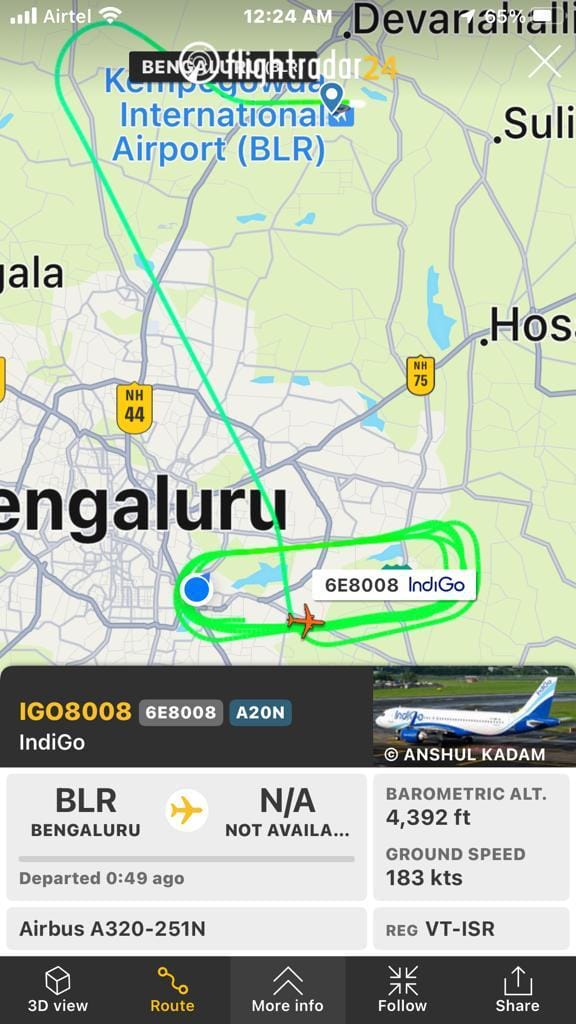Residents near the old HAL airport in Bengaluru have been finding peaceful living a problem over the past few months. Authorities at HAL have leased out their airport and airspace for civilian low-altitude, night time pilot training by civilian airlines. The list of such airlines includes Indigo, Vistara and Air India.
The aircraft operate at low altitudes-typically 3,000 feet to 5,000 feet above ground and take an elliptical predefined path, which passes over Koramangala, HSR layout, Sarjapur Road, Old Airport road, Kaggadasapura and other neighbouring areas. Training begins around midnight most days and goes on almost until daybreak.
It may be recalled that the Hindustan Aeronautics Airport was the only airport in Bengaluru, up to May 2008, when the new Kempegowda Airport in Devanahalli took over all scheduled commercial, civilian air traffic. HAL airport was left with just Air force operations, charter flights and VIP flight movement. It would appear that HAL has resorted to leasing out its facilities for this training in order to augment revenues.

Read more: Not by BIAL alone
Is HAL a manufacturing unit ?
In an interesting submission before the Hon’ble High Court of Karnataka, in Chalet Hotels P Ltd vs Hindustan Aeronautics Ltd in WP 37571/2013, the counsel representing HAL had stated before the court that HAL is “primarily a public sector undertaking carrying on manufacturing activity”. The same had been recorded by the Hon’ble High Court in its judgement in the writ petition.
If, as HAL have themselves conceded, Hindustan Aeronautics is a manufacturing facility then the provisions of the Karnataka State Pollution Control Board (KSPCB) certainly apply to it. KSPCB has categorised industries into colours — Red, Orange, Green and White. Out of these, the red category is reserved for highly polluting or sensitive industrial activities and operations. The very first item in the KSPCB red list is listed as “1,100 Airports and Commercial Air Strips”
It is very clear, therefore, that HAL falls squarely within the ambit of the KSPCB regulations on noise pollution both on account of it conducting manufacturing activity and because it operates as an airport. Units operating with a Consent to Operate (CTO), issued by the KSPCB, cannot change the scope of activity without a fresh CTO application. There is no indication of HAL having applied for the same from the KSPCB.
Read more: Nod to Raheja Viverea revoked: Chalet Hotel sues HAL
What are residents objecting to?
An online petition with hundreds of signatures was floated. A copy of it was sent to HAL by the Koramangala 3rd Block Residents Welfare Association (RWA) on behalf of several RWAs in the area. The petition made the following points:
- Residents do not object to military flight training or operations at any time of the day or night since this is a vital component of the country’s defence.
- Residents do not object to civilian flight training as long as this is conducted at hours applicable for similar activity over a residential area. In other words, they requested a silent zone between 10 pm and 6 am as many residents were being deprived of a peaceful night’s sleep.
- In response, HAL, in its email reply dated July 29th, avoided addressing the main issue until the very end of the communication. Instead it went into the history of HAL operations and digressed into a number of irrelevant considerations, including the impact on Defence preparedness. This would hardly be relevant as residents have time and again pointed out that their objection was only with respect to commercial civilian operations being conducted during the night .
- They also mentioned that “HAL supports the civil aviation growth of the country, which is growing at any unprecedented rate……… contributing to the GDP growth of the country”.
A reply was sent to HAL on August 1st pointing out that the core issue in the complaint had not been addressed. However, post this communication there has been silence from the HAL authorities.
What do the KSPCB noise pollution rules state ?
KSPCB, in its official communication No/PCB/NEC /1/2013-14/7908 dated 28 March 2014, has clearly laid down the standards for ambient noise in various zones as below:

Measurements made by residents from handheld mobile devices (which are admittedly approximate) show readings of more than 70 db when the flights pass directly overhead.
What Indian courts have said on this subject
A number of court judgements and pronouncements have addressed the issue of aircraft noise causing disturbances to residential communities.
In 2016, the Principal bench of the National Green Tribunal (NGT) had directed the Government to lay down standards for noise pollution linked to airports and report on suitable measures within two weeks.
Shortly thereafter, the Government notified standards for noise pollution within airport boundaries (which is a meaningless standard since nobody lives within an airport boundary). The limits were deemed to be as applicable for an Industrial area.
Various High Courts in the country have also heard similar cases, like this report on the Delhi High Court hearing a case on a similar ground in 2005. However, nothing emerged from these hearings.
It may be interesting to note that several airports in developed countries do not allow even regular commercial flights during the night to protect the rights of residents living nearby. A key example is London’s Heathrow Airport, which comes to a total halt during night time.
What recourse is left to residents ?
Residents plan to take up the matter with their elected representatives. If that approach fails then they will be forced to seek judicial recourse in the matter.